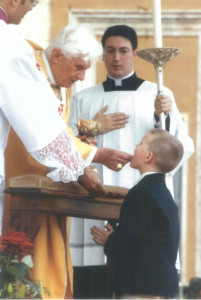This week’s TOB Tuesdays is a special edition.
Eucharistic Abstinence and NFP by Katrina J. Zeno, MTS
A funny thing happened on the way to Easter this year – Lent became even more penitential.
 Without our consent, public Catholic masses were suspended in many dioceses in the U.S. and other countries around the world. These decisions imposed a forced fasting from the Eucharist, the Bread of Life, and many people aired their grievances on social media, questioning the commitment of bishops and priests to their flock and our needs.
Without our consent, public Catholic masses were suspended in many dioceses in the U.S. and other countries around the world. These decisions imposed a forced fasting from the Eucharist, the Bread of Life, and many people aired their grievances on social media, questioning the commitment of bishops and priests to their flock and our needs.
But I think there’s another way of looking at this forced fast that mirrors Natural Family Planning and the marital one-flesh union.
It will come as no surprise for those who regularly read my books, blog, and social media posts that I am in awe of the intimate connection between the marital one-flesh union and the Eucharist. In fact, Pope Emeritus Benedict XVI, known for his theological and dogmatic clarity, wrote the following in his book, Spirit of the Liturgy: “In the Eucharist a communion takes place that corresponds to the union of man and woman in marriage. Just as they become ‘one flesh,’ so in Communion, we all become ‘one spirit,’ one person with Christ.”
Like my beloved St. John Paul II, Cardinal Ratzinger is merely expounding St. Paul’s proclamation in Ephesians 5:31-32: “ ‘For this reason, a man will leave his father and mother and unite with his wife and the two will become one body.’ This is a great mystery; I speak in reference to Christ and the Church.”
In reflecting on this particular Scripture passage, St. John Paul II in his Theology of the Body creates a wonderful coupling between Christ’s total gift of self in love as Redeemer and the revelation of Himself as the Divine Bridegroom. In two striking TOB statements that compete for the top spot of my favorite TOB quotes, JP2 wrote:
- “That gift of self to the Father through obedience to the point of death (see Phil 2:8) is at the same time, according to Ephesians, an act of ‘giving himself for the Church.’ In this expression, redeeming love transforms itself, I would say, into spousal love: by giving himself for the Church, with the same redeeming act, Christ united himself once and for all with her as the Bridegroom to the Bride, as the husband with the wife…” TOB A90:6)
- “…the gift given by God to man in Christ is a ‘total’ or ‘radical’ gift, which is precisely what the analogy of spousal love indicates: it is in some sense ‘all’ that God ‘could’ give of himself to man, considering the limited faculties of man as a creature.” (TOB A95b:4)
And, as if to substantiate and even further develop these statements about Christ’s redemptive and spousal love, St. JP2 devoted an entire section of his apostolic letter, “On the Dignity and Vocation of Women” to the Divine Bridegroom, the Bride, and the Eucharist (nos. 23-27). In two sentences, he condenses the meaning of life, history, and salvation by saying, “The ‘sincere gift’ contained in the Sacrifice of the Cross gives definitive prominence to the spousal meaning of God’s love…. The Eucharist is the Sacrament of our Redemption. It is the Sacrament the Bridegroom and the Bride” (no. 26)
As Cardinal Ratzinger noted, when we receive the Eucharist into our bodies, we become one body, one flesh with the Glorified Body of Christ. To use marital language, you and Christ “consummate” your “sacramental marriage” by entering into a one-flesh union through the Eucharist.
Perhaps at this point you are thinking, “Yes! This is exactly why the Eucharist must be made available to the faithful no matter what the cost.” And yet, here’s where we can learn a lesson from Natural Family Planning.
Embedded within the practice of NFP are times not only of consummation, but of abstinence: sometimes prolonged abstinence. Prolonged abstinence is never easy because the conjugal embrace is a good – it provides an intimate expression of love, tenderness, communication, and abiding in one another through the body that occurs no other way. This is why its absence in marriage is experienced as a lack, as a deep, interior sense that something is missing.
However, NFP couples also know that abstaining from the one-flesh marital union doesn’t mean isolation from each other but an opportunity to express love, tenderness, communication, and an abiding with each other through non-genital affection, tender and affirming words, other forms of communication such as gift-giving and quality time, along with the joy of abiding together as they share in the home and family life as a communion of persons.
After this prolonged time of abstinence, many couples express a renewed and even surprising sense of intimacy and fulfillment in consummating their marriage once again through their gift of self that is total, irrevocable, giving all that they can give.
Could this experience of the one-flesh abstinence in marriage shed light on the current Eucharistic one-flesh abstinence we are being asked to endure? I truly hope so. Just as a married couple fasts from the marital one-flesh union for a greater good (health of a spouse, the need to care the for the children they already have, economic and social difficulties, etc. – see Gaudium et Spes, no. 50), so, too, we can regard this time of Eucharistic one-flesh abstinence as ordered toward a greater good.
Just as a married couple fasts from the marital one-flesh union for a greater good (health of a spouse, the need to care the for the children they already have, economic and social difficulties, etc. – see Gaudium et Spes, no. 50), so, too, we can regard this time of Eucharistic one-flesh abstinence as ordered toward a greater good.
In this case, the greater good is not necessarily our nuclear family, but our national family – it is the greater good of the health of the broader society and even the global, international community. This is indeed a great sacrifice on the part of Catholics, but it does not mean our intimacy with our Divine Spouse is sabotaged. Like the abstaining married couple, we are invited to rediscover other ways in which spousal intimacy and communion are expressed. Primary among these ways is reading and abiding in the Word of God.
We are incredibly blessed to be able to hold the Word of Life in our hands! While it is not the Body of Christ Himself, it is still God’s revelation of Himself in and through history, first in the Old Covenant and then in the New Covenant.
We are incredibly blessed to be able to hold the Word of Life in our hands! While it is not the Body of Christ Himself, it is still God’s revelation of Himself in and through history, first in the Old Covenant and then in the New Covenant. In the absence of the Liturgy of the Eucharist, we can abide in the (liturgy of the) Word of God and let it abide in us for 15 minutes, 30 minutes, an hour if we so wish! And in God’s Word, we can encounter anew the intimate expression of God’s spousal love for us in the Song of Songs and the Gospel of John; His tenderness for us in the psalms and the prophets; and the communication of his salvific plan through marriage beginning with Adam and Eve and continuing all the way through the New Testament culminating in the book of Revelation.
The keystone to this nuptial or marital shape of salvation is, of course, the New Covenant sealed in the blood of the Divine Bridegroom, awaiting its final consummation through the return of the Glorified Bridegroom when the new Jerusalem shall shine forth in all her Splendor as the Bride of the Lamb (Rev. 22:2). Growing in knowledge of the nuptial shape of God’s relationship with each of us is never wasted time; it is the penitential invitation to jump into the deep end of “faith seeking understanding” and be refreshed and inspired by the whole stream of nuptial theology present in Sacred Scripture and our Catholic Tradition. During this time of one-flesh Eucharistic abstinence perhaps the Divine Bridegroom desires each of us to discover the nuptial shape of our whole life in Christ.
On a practical note, permit me to share how I’ve drawn inspiration from a rather unlikely source for participating in on-line daily mass at home – from those who have undergone permanent sterilization and then experienced repentance and contrition for their error.
 Married couples who have come to realize the stark and sad error of their choice to be permanently sterilized are not required by the Church to seek a sterilization reversal (although they are encouraged to consider this). However, the Church does recommend that they live the rhythm of married life as if they were fertile. This means choosing, in advance, one week a month to abstain from the marital one-flesh union in order to cultivate the virtues of self-mastery and self-discipline that are fruits of chastity.
Married couples who have come to realize the stark and sad error of their choice to be permanently sterilized are not required by the Church to seek a sterilization reversal (although they are encouraged to consider this). However, the Church does recommend that they live the rhythm of married life as if they were fertile. This means choosing, in advance, one week a month to abstain from the marital one-flesh union in order to cultivate the virtues of self-mastery and self-discipline that are fruits of chastity.
In our current situation, we can likewise do the same. We can cultivate the virtues of self-mastery and self-discipline by choosing in advance a daily time to watch either a live-streamed or pre-recorded celebration of the Mass. Then, and this where a true attentiveness is required, we FAST for one hour before the time when we would have received Holy Communion if we were in actual attendance. In my condo, I have made a small altar out of a table by placing an image of the Sacred Heart on it flanked by two votive candles. I place my laptop just to the side of the image, turn my cell phone off, light the candles, and then participate in Mass as if I were actually there: sitting, standing, kneeling, and saying the responses at the appropriate times. During Holy Communion, I sing a “spiritual communion” that I put to music some twenty years ago to teach my son.
This practice encourages us to maintain the same rhythm of life as if we were celebrating mass in person by being aware of the required time of fasting and stopping our daily activity to be in union and communion with Christ and the Trinity, albeit it spiritually. While it’s tempting to regard this time off from work, school, and other responsibilities as if we were on vacation, remaining faithful to the daily or Sunday rhythm of Mass reminds us to keep spiritually attuned during this worldwide pandemic and to intercede for those suffering and in need, both in terms of physical health and economic hardship. And when we finally have the opportunity to consummate again our spousal love with Christ in the Eucharist, we may well be surprised and awed at the new sense of intimacy we feel and the growth in ourselves to make a gift of self in love that is total, irrevocable, perhaps giving even more than we gave to God before our Eucharistic fast.
Katrina J. Zeno, MTS
(Please “share” this blog – and invite your friends to like the JPII Resource Center FB page. Thank you.)
Jack Henz’ Reflection: From Darkness into Light: God’s Unexpected Spousal Embrace
My garden and backyard are ablaze with spring colors and possibilities. Lime and pomegranate flowers mix their fragrances with that of roses, freesia, and carnations in the warm breeze. Arizona wildflowers burst forth, decorating the foothills with yellows, oranges, and blues. It’s almost spring and anything seems possible.
In stark contrast, the dark curtain of the Coronavirus hinders the budding forth of normal spring joy. Mother Nature’s dark side seems to prevail as the virus’ death toll mounts and “stay-in-place” mandates severely reduce social interaction, imposing an unnatural isolation on many.
Then the Bishop’s Statement arrived in my email, and what a jolt: all public Masses, general Penance services, religious ed programs, and parish events of more than 10 persons were indefinitely suspended. The tangible availability of Eucharistic union with Jesus abruptly ended. We and our parish family members were suddenly cut-off from one another. I could feel the dominating darkness creeping in. The coming light of Easter Resurrection couldn’t arrive soon enough!
 In the spiritual darkness and confusion, I found some much needed hope in reading Katrina’s *special edition* blog this week. She offered several ways to enter into Spiritual Communion, including celebrating online Masses at home in a rhythm consistent with a normal Mass. My wife, Karen, and I have adopted this idea for daily and Sunday Mass. It’s offered a satisfying and spiritual foundation for weathering the temporary loss of union and communion at Mass while also maintaining a different kind of liturgical rhythm for our lives.
In the spiritual darkness and confusion, I found some much needed hope in reading Katrina’s *special edition* blog this week. She offered several ways to enter into Spiritual Communion, including celebrating online Masses at home in a rhythm consistent with a normal Mass. My wife, Karen, and I have adopted this idea for daily and Sunday Mass. It’s offered a satisfying and spiritual foundation for weathering the temporary loss of union and communion at Mass while also maintaining a different kind of liturgical rhythm for our lives.
Among Katrina’s other suggestions, one in particular resonated with me: abiding in the Liturgy of the Word of God as a means of encountering anew the intimate expression of God’s spousal love for us.
In re-reading the Song of Songs, I was immediately reminded of God’s persistent, passion for His Bride, the Church – from creation to the most turbulent of times in the Old Testament to the troubling present.
In re-reading the Song of Songs, I was immediately reminded of God’s persistent, passion for His Bride, the Church – from creation to the most turbulent of times in the Old Testament to the troubling present. Like the fragrant, colorful flowers in my garden, God’s words of love for us filled my afternoon with hope and thanksgiving. His gentleness and genuine concern for our well-being literally burst forth from the words. Whew, that was a passionate read.
Katrina also mentioned the Gospel of John which, by chance, I started reading and reflecting on in my Lenten personal prayer time. Early Sunday morning, I read the Gospel for the day from John 9 where Jesus heals the man born blind. When quizzed about the cause of this man’s blindness, Jesus responded, “It was not that this man sinned, or his parents, but that the works of God might be made manifest in him.” Jesus then restored eye-sight to a man who had never seen.
As I reflected on God’s Word, I wondered: Is it possible the man’s infirmed condition was a metaphor for humankind’s spiritual blindness? Was the healing performed by Jesus a reference to God’s work of restoring our spiritual eye-sight to see our lives in light of His spousal plan for us? Certainly, it offers the bright hope that we can unexpectedly see God’s spousal embrace being extended to us in many ways during this troubling time.
Was the healing performed by Jesus a reference to God’s work of restoring our spiritual eye-sight to see our lives in light of His spousal plan for us? Certainly, it offers the bright hope that we can unexpectedly see God’s spousal embrace being extended to us in many ways during this troubling time.
Last week, I shared how I had observed the unitive power of the body through a variety of gifts-of-self made by others at the grocery store, in the rain, etc. Little did I know that I would need this same type of self-giving to express God’s spousal embrace for me during this dark week: Karen is a four-time cancer survivor with a compromised immune system and we are both in the high-risk age category (over 65 years). Call it double indemnity requiring almost no social contact.
Then, out of the blue, the doorbell rang. I opened the door to find my next-door neighbor – a retired policeman – exuberantly greeting me along with his two small Yorkies. He kindly asked how Karen and I were doing and added that he remembered Karen’s cancer-compromised condition had probably pinned us to our home. He quickly volunteered to go to the store or run errands for us as needed. His smile and sincere words almost brought tears to my eyes. I quickly responded that we’d take him up on his offer and thanked him for his concern. He said, “You guys prayed for my safety when I was working. It’s the least I can do for you two. Time to walk these guys. Bye.”
Once inside, I felt motivated to call one of the Four Amigos (see my Blog 5 reflections) to see how he was doing. He’s 82 years old and lost part of a lung to Valley Fever. All he needed, he said, was a board puzzle to do and his life would be fine. After we hung up, I got the board puzzle, a 1000-piece Van Gogh I was saving for his birthday, and drove to his home. As I passed it to him quickly through the open door he said, “You’re a saint.” Well not yet, but I keep trying.
When I got home, Karen had amazing corned beef and sauerkraut on swiss and rye sandwiches for lunch. She thanked me for running the puzzle over to our friend. “I made these special for you,” she said.
As we prayed before eating, the thought raced through my mind that just like the blind man in John’s Gospel, my spiritual blindness had faded in the light of God’s sweet spousal embrace that encompassed my day. The dark, virus curtains had been parted by the spiritual communions I had experienced through God’s Scriptural words of love and the acts of kindness received and given.
Life felt good and bright again. Even my John Paul II rose bushes seemed to agree as their first spring rosebuds began to appear. Could this be a coincidence or another simple expression of God’s warm spousal embrace for me?
©by Jack Henz
We invite you to share your own 2-3 line reflection on our JPII Resource Center Facebook page by clicking here.
*Jack Henz is a retired meteorologist and a graduate of the Diocese of Phoenix ‘s Kino Catechetical Institute. Together with his wife Karen, he is a passionate catechist concerning all things Catholic, especially the Theology of the Body.




